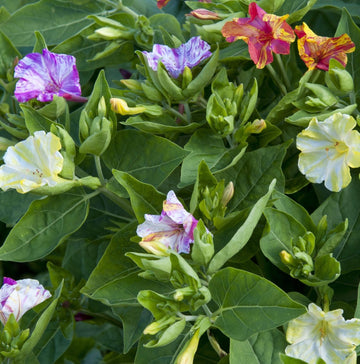Hey there, fellow green thumbs and budding plant enthusiasts! Today, let's chat about a plant that's stolen my heart over the past couple of years. Say hello to Mirabilis Jalapa, my garden's showstopper! You might be more familiar with its snazzy nickname, the Four o'clock plant, or perhaps you've heard it called Beauty of the Night or even Marvel of Peru. If you wander over to China, they've got some fun names for it too, like the Rice Boiling Plant or Shower Flower. And in Hong Kong? It goes by Purple Jasmine.
Now, let's dig a bit into its roots, quite literally! Mirabilis Jalapa is a South American native and has been brightening up European gardens for about 500 years. What makes it so special? Well, for starters, it's a sun worshipper. However, just like some of us on a ski holiday, it can't handle the cold. Typically grown as an annual, this plant is pretty versatile when it comes to surviving the off-season. In autumn, when it starts to retreat, you can lift and store its tubers (kinda like you would with dahlias), or if your winters are more "chilly" than "frosty," you can leave them be.
This year, I played a little experiment. I planted some using last year's tubers and others from seed, starting both around the same time. The tubers were like sprinters off the blocks, already showing off their blooms, while the seed-grown plants are still getting their bearings. A hot tip if you're starting from seeds: give them a day-long soak first. They germinate like a dream afterwards!
Mirabilis Jalapa is quite the grower, reaching up to 3ft. It's not too fussy about soil, though it seems to favor a slightly alkaline touch. That's probably why it thrives in my garden, with our hard water creating a lime-friendly environment. But here's the catch: it's thirsty! Neglect its water needs, and it'll droop dramatically. Yet, give it a good soak, and voila – it bounces back beautifully.
Now, let's talk about the main event – the flowers. They're prolific, with a kaleidoscope of colors and sometimes even variegated patterns. They're perfectly paired with bright green leaves, which are half the reason I adore this plant. These blossoms are evening stars, opening up at dusk (hence the cool names), and sometimes, you'll see different colored flowers on the same plant! They're fleeting beauties, though, lasting just a day, but don't worry – new ones pop up right away.
But wait, there's more! After the flower show, you get these large, attractive seeds that turn from greeny-yellow to black, creating a striking contrast with the foliage. If you let them, they'll self-seed in your garden, but collecting seeds is also doable (though a bit of a task with how many there are).
A word of caution: while they look charming, Mirabilis Jalapa seeds (and other parts of the plant) are not snack material. They're poisonous, so if you've got curious kiddos around, keep an eye out.
Despite its toxicity, it's been a medicinal marvel for ages, boasting antifungal and antiviral properties. In fact, some of its chemical compounds are now used in products to protect crops like corn and potatoes from viruses.
And guess what? Pests seem to give it a wide berth too. While other plants in my garden are having a tough time with red spider mites or powdery mildew, my Four o'clocks are living their best life, healthy and vibrant. That resilience alone earns them a VIP spot on my balcony year after year.
So, there you have it, the tale of my garden's shining star, Mirabilis Jalapa. If you're looking for a plant that's both a stunner and a survivor, you might just want to give this one a whirl. Happy gardening, everyone!
My Balcony's Star Performer: The Mirabilis Jalapa Story

